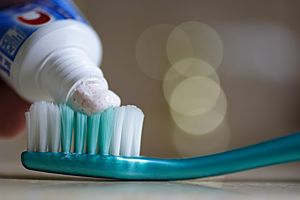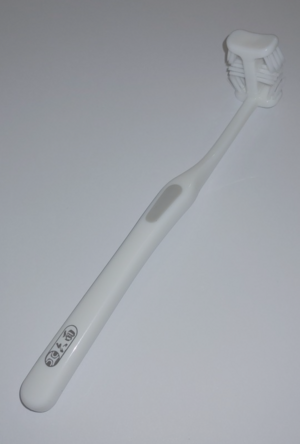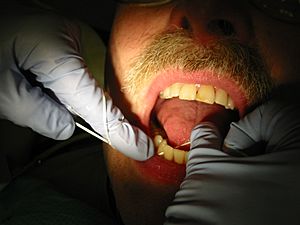Oral hygiene facts for kids
Oral hygiene is all about keeping your mouth clean and healthy! It means regularly brushing your teeth and gums to prevent problems like tooth decay (cavities) and gum disease. Good oral hygiene also helps stop bad breath. When you take care of your mouth every day, you protect your teeth and gums from getting sick.
General advice for kids and teens is to brush at least twice a day. Brush before bed at night and after breakfast in the morning. Always use a toothpaste with fluoride. Cleaning between your teeth is just as important as brushing. A toothbrush can't reach these tight spots. Tools like floss or interdental brushes help remove plaque from between your teeth.
Sometimes, people think clean teeth must be perfectly white or straight. But a healthy mouth can still have stained or crooked teeth. People might use tooth whitening treatments or orthodontics (like braces) to change how their teeth look.
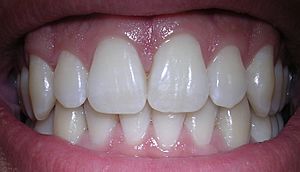
Your mouth is full of tiny living things, mostly bacteria. Most of these are helpful, but some can cause problems. If you don't clean your teeth well, these bacteria can grow and lead to cavities and gum disease. Scientists have learned that our mouth bacteria have changed a lot over time. In the past, cavities were rare. Now, they are very common, affecting many schoolchildren.
Contents
Keeping Teeth Clean and Healthy
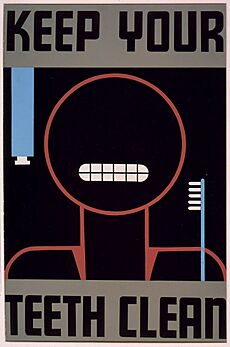
Tooth decay (cavities) is the most common dental problem worldwide. It often forms in tiny grooves on your back teeth. These spots are hard for your toothbrush to reach. Food can get stuck there, and acids can attack your teeth. Regular teeth cleaning removes dental plaque and tartar. This helps prevent cavities and gum disease. Severe gum disease can even lead to losing teeth if not treated.
People have cleaned their teeth for a very long time! Ancient tools included chew sticks and twigs. In some cultures, like in India, people still use neem twigs. These twigs act like natural toothbrushes. In the Muslim world, the miswak twig is used for its cleaning properties.
It's a good idea to visit your dentist regularly. For kids, it's often recommended every two years. Your dentist can tell you what's best for your teeth. Professional cleanings remove plaque and tartar that you can't get rid of at home. They might also apply fluoride to strengthen your teeth.
Dentists can also apply sealants to your back teeth. These are protective coatings that fill in the grooves. They stop food from getting trapped and prevent cavities.
Between dental visits, good oral hygiene at home is key. This means careful, frequent brushing. Also, use dental floss or interdental brushes to stop plaque from building up. Powered toothbrushes can reduce plaque and gingivitis more than manual ones.
Parents need to teach their children good brushing and flossing habits early on.
What Causes Dental Problems?
Even with good brushing, sometimes problems can start. It's important to know what causes them.
What is Dental Plaque?
Dental plaque is a sticky, yellowish film. It's made of many tiny bacteria. Plaque sticks to your teeth, especially near the gum line. It starts to form again soon after you clean your teeth. That's why you need to brush often!
Eating lots of sugary foods helps plaque grow. The bacteria in plaque turn sugar into acid. This acid then attacks your tooth enamel, causing cavities.
If plaque stays under your gums, it can make them red and swollen. This is called gingivitis. Your gums might even bleed when you brush or floss. These are signs that your gums are not healthy.
Hardened Plaque: Calculus
If plaque stays on your teeth for too long, it gets hard. This hard substance is called calculus (or tartar). Once plaque turns into calculus, you can't remove it with just a toothbrush. A dental hygienist or dentist needs to clean it off. If calculus isn't removed, it can lead to serious gum disease and even tooth loss.
How to Prevent Dental Problems
Taking care of your teeth every day is the best way to keep them healthy. Here are some important steps.
Brushing Your Teeth Properly
Brushing your teeth regularly is the main way to prevent many mouth diseases. It helps remove plaque buildup. Less plaque means less risk of cavities and gum problems. Most people brush for about 30 to 60 seconds. But dental experts suggest brushing for at least two minutes, twice a day. Brushing for two minutes removes much more plaque than brushing for a shorter time.
Using toothpaste with fluoride is very important. Fluoride helps protect your teeth from cavities. It also helps repair tooth enamel that has been slightly damaged.
Manual Toothbrushes
A manual toothbrush has nylon bristles on a head and a long handle. The handle helps you reach all your teeth, even the ones in the back. It's your best tool for removing plaque. Dental professionals recommend a toothbrush with a small head and soft bristles. These are effective without harming your gums.
The way you brush matters! Don't just brush back and forth. Angle the bristles at 45 degrees towards your gums. Then, use small circular motions. This helps clean plaque from your gum line effectively.
Electric Toothbrushes
Electric toothbrushes have heads that move or vibrate. Some vibrate very fast (sonic type). Others rotate back and forth (oscillating-rotating type). Electric toothbrushes can be more expensive. They might also have a bigger environmental impact than manual ones.
These brushes can be easier to use, especially for kids or people with limited hand movement. You just guide the brush slowly from tooth to tooth. The brush does the work of moving the bristles for you. This helps break up bacteria even below the gum line.
Flossing for Clean Gaps
Brushing alone can't clean between your teeth. About 40% of your tooth surfaces are in these tight spaces! That's where dental floss comes in. When used correctly, floss removes plaque and food bits from between teeth and under the gums. The American Dental Association suggests flossing every day.
There are different types of floss:
- Unwaxed floss: Made of nylon threads that spread out to catch plaque.
- Waxed floss: Stronger and less likely to tear, good for tight spaces.
- Polytetrafluoroethylene (like Teflon): Slides easily and doesn't fray.
The best type of floss is the one you use regularly and correctly. Here's how to floss:
- Get about 15–25 cm of floss. Wrap most of it around your middle fingers.
- Hold a small section (about an inch) tightly between your thumbs and index fingers.
- Gently slide the floss between your teeth using a back-and-forth motion.
- Curve the floss into a 'C' shape around one tooth. Slide it up and down, making sure to go slightly under the gum line.
- Repeat for each tooth, using a clean section of floss.
If you find flossing hard, there are tools like floss threaders (for braces) or flossettes (small holders with floss) that can help.
Interdental Brushes
Interdental brushes are small brushes with bristles on a wire. They come in different sizes. You use them to clean the spaces between your teeth. Studies show they can be as good as or even better than floss for removing plaque and reducing gum swelling. They are great for people with braces.
How to use an interdental brush:
- Choose the largest size that fits comfortably without forcing it.
- Gently insert the brush straight into the space between your teeth.
- Move the brush back and forth a few times.
- Rinse the brush under water to clean it. Store it in a clean, dry place.
- Replace the brush when the bristles look worn out.
Tongue Scrapers for Fresh Breath
Your tongue can hold many bacteria that cause bad breath (also called halitosis). Tongue cleaners are designed to remove this buildup. You can also try brushing your tongue with your toothbrush, but a scraper might be more effective for the back of the tongue.
How to use a tongue scraper:
- Rinse the scraper first.
- Start at the back of your tongue and gently scrape forward.
- Make sure to clean the sides and the middle of your tongue.
- Rinse the scraper and your mouth when you're done.
Other Cleaning Tools
- Oral irrigators: These devices use a stream of water to clean between teeth and under the gums. They can be used instead of or with floss.
- Single-tufted brushes: These small brushes are great for cleaning hard-to-reach spots. This includes behind your front teeth, around back molars, or crooked teeth.
- Gum stimulators: These tools have soft rubber tips. They are used to gently massage your gum line. This helps improve blood flow and remove bacteria.
- Dental probiotics: Some people use special probiotics to help with gum health and bad breath.
Food and Drink for Healthy Teeth
What you eat and drink affects your teeth and gums. A balanced diet helps keep your whole mouth strong.
Smart Food Choices
Eating healthy foods and limiting sugary snacks helps prevent cavities and gum disease. Foods like raw vegetables, plain yogurt, cheese, and fruit are good for your teeth. They help keep your mouth healthy.
Chewing Gum Benefits
Chewing gum can help clean your teeth by increasing saliva flow. Saliva washes away food particles. Sugar-free chewing gum is best because it doesn't feed the bacteria that cause cavities. However, if you have loose fillings, chewing gum might pull them out.
Avoid Chewing Ice
Chewing on hard things like ice can chip or crack your teeth. This can lead to more serious tooth damage.
Other Habits Affecting Oral Health
Avoiding Harmful Habits
Certain habits, like using tobacco products, can seriously damage your gums and teeth. They can make your gums more likely to get sick and make it harder for them to heal.
Mouthwash
Mouthwash can be a helpful addition to your oral hygiene routine, but it doesn't replace brushing and flossing.
Types of Mouthwash
- Saline (salty water): Often recommended after dental procedures, like having a tooth removed. It can help with healing.
- Essential oils or CPC mouthwash: These types, found in brands like Listerine or Colgate Plax, can help reduce plaque and gum inflammation when used along with brushing and flossing.
- Chlorhexidine: This is a strong antiseptic mouthwash. It's usually used for short periods, like after surgery, because it can cause temporary brown stains on teeth and tongue.
Caring for Dental Appliances
If you wear dentures, retainers, or braces, they need special care to stay clean and effective.
Dentures Care
Dentures must be kept very clean. Clean them twice a day with a soft brush and special denture paste. Don't use regular toothpaste, as it can scratch them. It's best to take dentures out at night. This helps prevent gum problems and other health issues. Store them dry overnight. Soaking them once a week in a special cleaning tablet can also help keep them clean.
Retainers Care
Clean your retainers properly at least once a day. Use soap and cold water, not toothpaste. Soaking them once a week in an alkaline-peroxide cleaning tablet is also good. Hot water can warp your retainer, so always use cold water. Keep your retainer in its case when not wearing it.
Braces Care
If you have braces, you need to be extra careful with cleaning. Use a small or special toothbrush with soft bristles to reach all areas. Brush after every meal. A high-fluoride toothpaste can be very helpful. Regular flossing is also super important to remove food and plaque stuck in your braces. Floss threaders or interdental brushes can make this easier. Your dentist might also apply fluoride foam during your check-ups to help prevent cavities.
Becoming a Dental Hygienist
If you're interested in helping people keep their smiles healthy, you could become a dental hygienist! In the U.S., you need to go to an approved college or university. An associate degree usually takes two years. With this, you can work in a dental office. You can also get a bachelor's degree or master's degree if you want to teach or do research.
Oral Health and Your Body
Your oral health is connected to your overall health. Problems in your mouth can sometimes affect other parts of your body.
Links to Other Health Issues
Some studies suggest that gum disease and inflammation in your mouth can be linked to other health problems in the body. These can include:
- cardiovascular disease (like heart attacks and strokes)
- Bacterial pneumonia: Good oral care for very sick patients has been shown to lower the risk of certain lung infections.
- diabetes complications
- osteoporosis
Oral Health and Mental Well-being
There's a connection between how you feel mentally and how you take care of your teeth.
How Mental Health Affects Oral Care
People who are struggling with their mental health might find it harder to keep up with daily oral hygiene. This can lead to problems like dry mouth, cavities, jaw pain, and gum disease. Studies have shown that people with mental health challenges may have a higher chance of losing their teeth.
Sometimes, people might avoid going to the dentist because they worry about being judged. It's important to remember that dentists are there to help everyone. Taking care of your teeth is a part of your overall well-being. If you're finding it hard to care for your teeth, talking to a trusted adult or your dentist can help. Learning about proper cleaning methods can also make a big difference.
See also
 In Spanish: Higiene bucodental para niños
In Spanish: Higiene bucodental para niños
- Dental floss
- Mouth breathing
- Obligate nasal breathing
- Periodontology
- Tooth brushing
- List of oral health and dental topics
- List of basic dentistry topics


